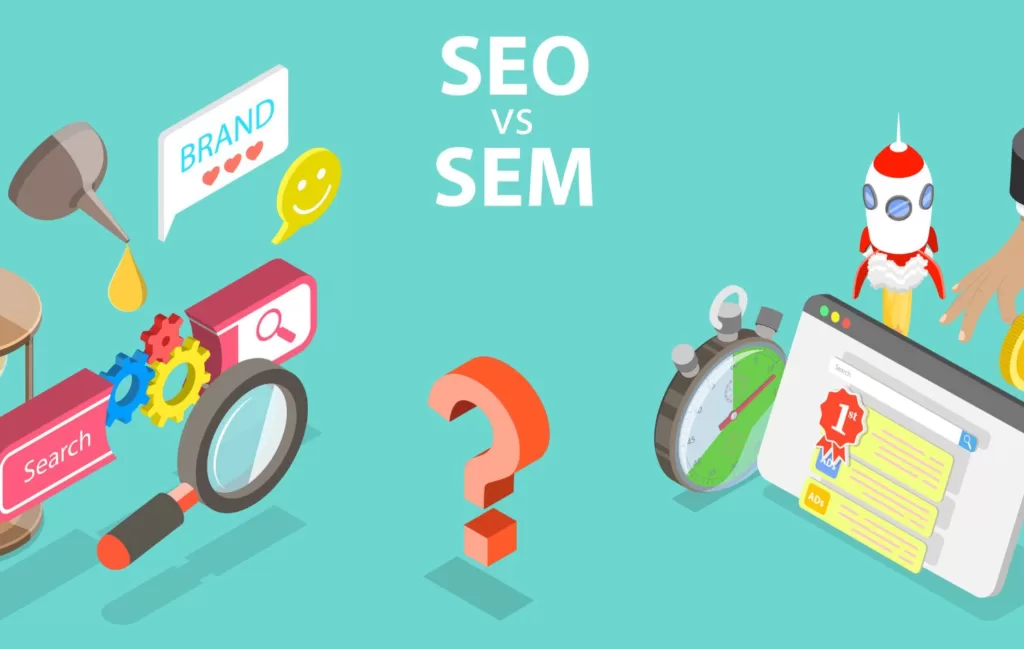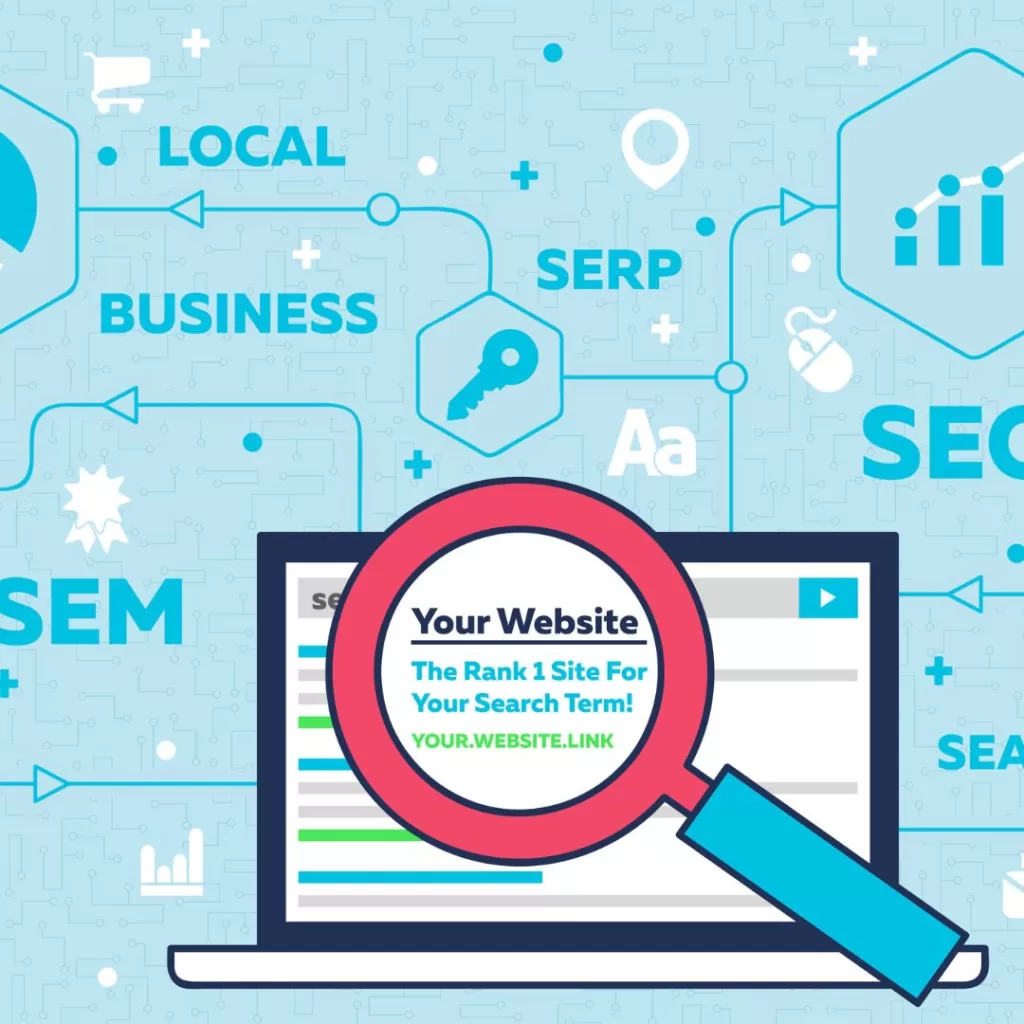Search Engine Marketing vs. Search Engine Optimization – Serving Two Different Search Intent Purposes

Let’s explain the difference between SEO and SEM. Search Engine Marketing, otherwise called SEM or Pay-Per-Click (PPC), is a form of paid search that costs a business money to boost its ranking or placement in search engines.
Search Engine Optimization is a strategy that helps increase a business’s placement in search engines. You’re probably wondering, why pay for SEM if SEO is free?
Overall, Search Engine Marketing has a greater impact compared to Search Engine Optimization, because SEM focuses on the customers’ intent (what they type into the Google search bar). For instance, when a customer types in “jeans for sale” or “best sushi near me” these searches show that the customer intends to buy and convert a lead into a sale. Paid search (SEM) is a perfect match for this marketing strategy, as it increases your return on investment (ROI).
Where SEO comes on top is when search queries are more research-oriented and informational rather than based on user intent. “How to crochet a baby blanket” or “when does the World Cup start” are research-based searches that focus on retrieving answers or solutions. Rather than using the searches to purchase a product or service, the intent is to learn something new. Understanding intent is a critical component to understanding digital marketing. Although Search Engine Optimization doesn’t technically generate revenue, it doesn’t mean that you should scratch it completely. The reason why is while a customer discovers your content, they’ll become a customer eventually. SEO works on building trust with users and fostering long-term relationships. Understand the unique benefits SEO and SEM provide, and utilize them to spearhead a powerful digital marketing strategy.
Why You Should Integrate SEM and SEO

Now that you know what SEO and SEM do; it’s time to combine what they both do and implement them into a cohesive digital marketing strategy by building off the “search intent” discussion mentioned earlier. It’s time to put what you learned into action!
First, we need to create a list of SEO-driven keywords that are relevant to your brand. Then, separate them into three individual lists based on the level of intent. For example, one list would be for buyer-intent keywords to drive sales, one list would be for research-intent to boost Google Search rankings, and the other list would be for middle-ground intent keywords where it’s more challenging to decipher between an intent to buy/convert or an intent to research/learn.
Putting these best practices into place will help you utilize your paid search marketing budget more efficiently by focusing heavily on crafting targeted keywords relative to an intent to convert. Placing research-based keywords that are meant for Search Engine Optimization into the Search Engine Marketing/Pay-Per-Click marketing strategy can cost more in the long run without seeing a positive ROI. If your PPC budget allows for increased spending on more buyer-intent keywords with money left over, then add in more research-based keywords.

The overarching purpose of aligning your SEO and SEM strategies together is to prevent unnecessary expenditures on paid searches. Both SEM and SEO heavily rely on keywords—that’s what drives traffic. Targeting keywords through SEO research that’s relative to research-based keywords saves you money in your SEM/PPC marketing approach. This way, you’re covered in each step of the online journey for buying a product or service since the user will always research (SEO) before making a purchase (SEM).
So, if you haven’t learned already, boosting both of these marketing strategies will drive enormous potential to launch a powerhouse digital marketing team that increases brand awareness, drives recognition, and boosts a higher ranking in Google Search engines through a multi-touchpoint approach.
Trends to Keep in Mind for Your SEO and SEM Strategy

Trends are always changing. Here are key things you should prioritize to initiate an effective digital marketing strategy:
Ensure your website is SEO-friendly. Incorporating optimized keywords that associate with your business, brand, and target customer will generate digital foot traffic and increase the chances of user purchases.
Maintain a friendly user experience (UX) when updating your website content. Creating an enjoyable and simplified experience for new and returning customers will not only boost brand loyalty but also drive more traffic to your site.
Craft a mobile-first experience. Curate an approach that innovates product design for mobile devices first. That way, your website will be accessible across multiple digital channels, no matter if a customer is on their phone or computer.
In a growing digital age, data-driven campaigns will continue to grow and become more accessible in the future. As technological advances continue, there will be an increased ability to personalize SEO and SEM campaigns as well as target opportunities for paid advertisements.
Please note: always ensure the data you receive is not crossing illegal boundaries, as privacy is a highly debated topic.
When do These Two Specific Strategies Become Essential to Your Marketing Operations?
Search Engine Optimization and Search Engine Marketing are both essential strategies to a company’s marketing operations. It doesn’t matter if someone is just starting a business or has been working for an established corporation for over a decade—you should implement SEO and SEM into the overall marketing plan. If an entrepreneur isn’t familiar with either of these two marketing strategies, invest the time to research and learn the ins and outs of them or hire a marketing professional.
What Happens If I Don’t Utilize SEM and SEO Together?

To keep it simple, not utilizing SEO and SEM strategies will not allow your business to make a maximum impact on a digital scale. For example, if you don’t use promotions with Paid Social or Pay-Per-Click (PPC) Campaigns, your business won’t generate promotional growth and increase product awareness. Putting your brand out there is what will drive traffic. Not refreshing your website content or leveraging proper Search Engine Optimization practices can result in a poor Google Search ranking or minimal website traffic. Not using SEO or SEM strategies together will cost more in the long run. If you want to grow your business, find ways to develop and implement digital marketing strategies that incorporate SEO and SEM.
Let Our SEM & SEO Experts do the Hard Work for You!
We live and breathe digital marketing; we are Google My Business Experts, Google Partners, Google Analytics Certified, SEMrush Experts, AMP (accelerated mobile pages) Implementation Qualified, and Google Tag Manager Experts. As your digital implementation leader, we’ll partner with you to combine data-driven strategies and optimize performance with both your SEO and SEM marketing campaigns. Want to get the most out of your digital marketing?
Contact us today to discuss your budget and establish your next steps.
Don’t try and do it all—let us leverage tactical practices to improve your business’s search ranking and conversion rates.






